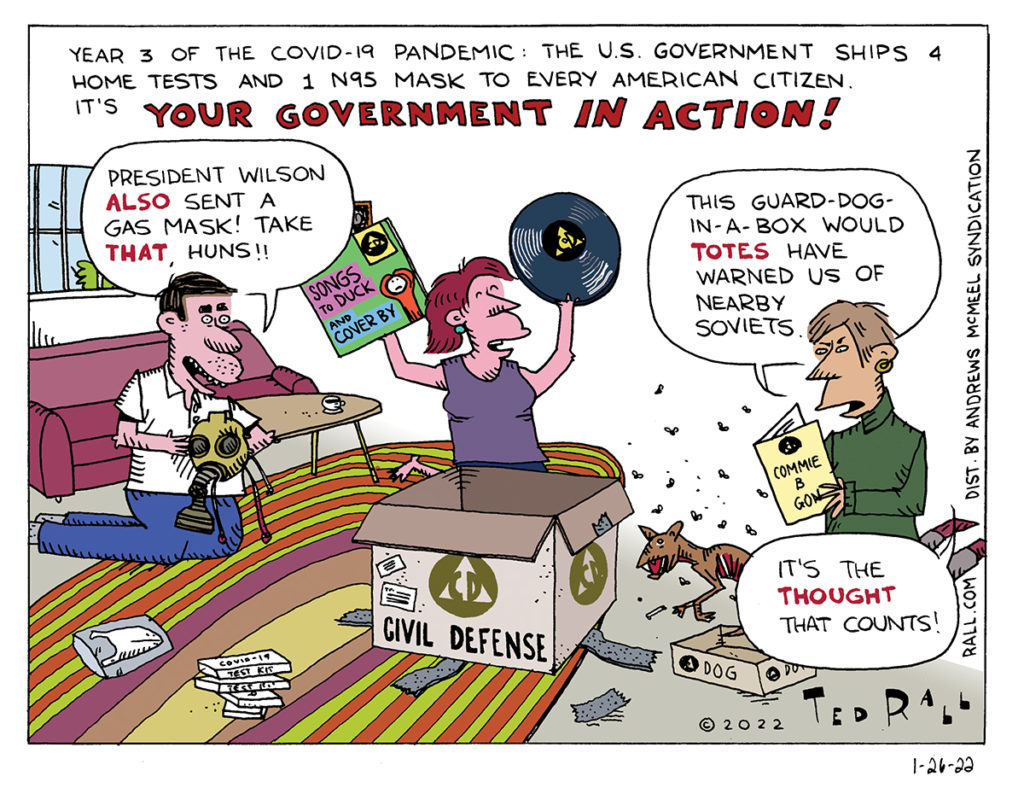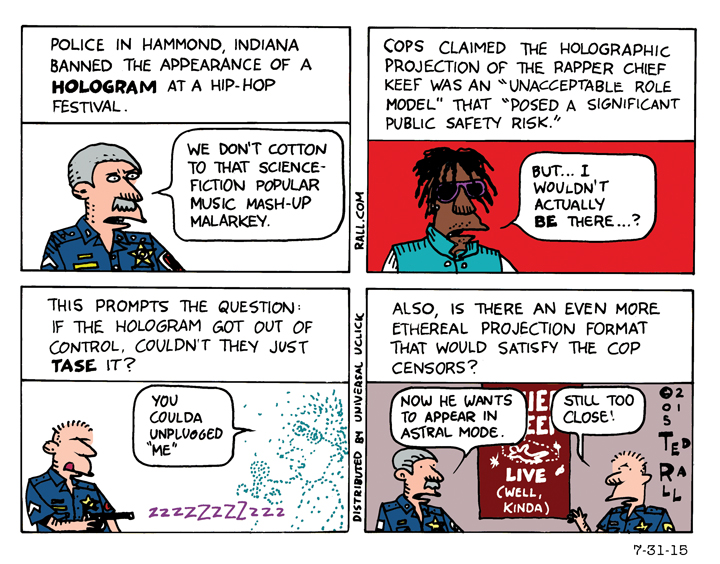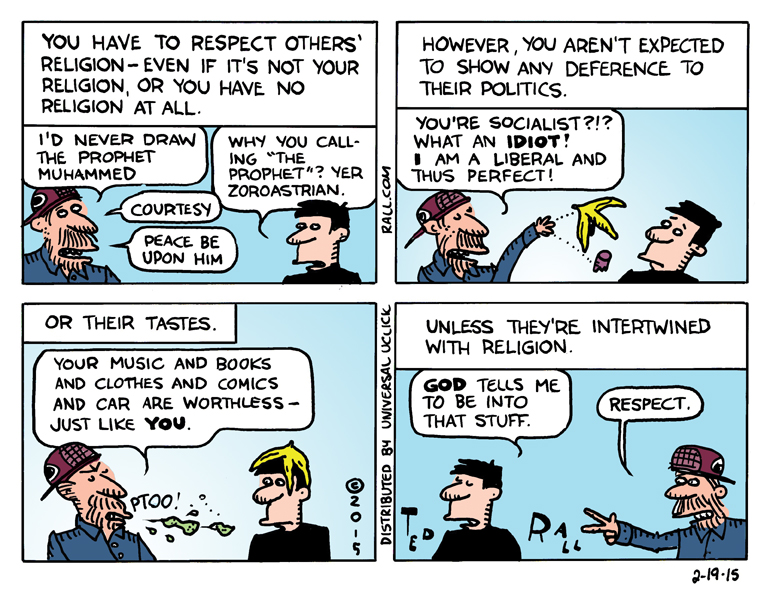When the COVID-19 pandemic first began, the US government should have began immediately shipping hundreds of masks to every American family from some giant warehouse somewhere. Now it’s the third year of the pandemic and everyone is getting one. If it’s the thought that counts, there hasn’t been much thought.
SYNDICATED COLUMN: Welcome to the Digital Dark Ages: Movies and Books Get Deleted as Selfies Pile Up
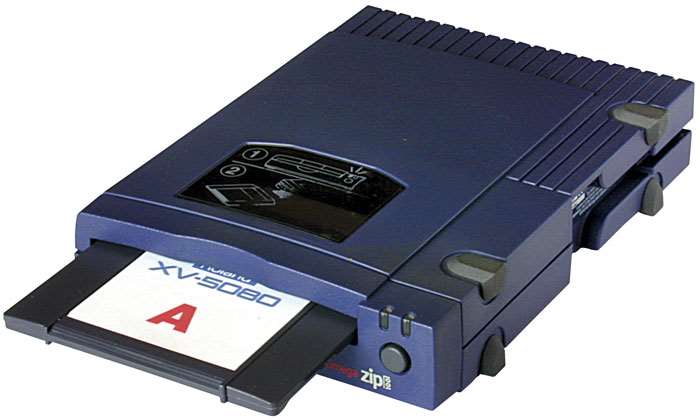 Historians and archivists call our times the “digital dark ages.” The name evokes the medieval period that followed the collapse of the Roman Empire, which led to a radical decline in the recorded history of the West for 1000 years. But don’t blame the Visigoths or the Vandals. The culprit is the ephemeral nature of digital recording devices. Remember all the stuff you stored on floppy discs, now lost forever? Over the last 25 years, we’ve seen big 8” floppies replaced by 5.25” medium replaced by little 3.5” floppies, Zip discs and CD-ROMs, external hard drives and now the Cloud — and let’s not forget memory sticks and also-rans like the DAT and Minidisc.
Historians and archivists call our times the “digital dark ages.” The name evokes the medieval period that followed the collapse of the Roman Empire, which led to a radical decline in the recorded history of the West for 1000 years. But don’t blame the Visigoths or the Vandals. The culprit is the ephemeral nature of digital recording devices. Remember all the stuff you stored on floppy discs, now lost forever? Over the last 25 years, we’ve seen big 8” floppies replaced by 5.25” medium replaced by little 3.5” floppies, Zip discs and CD-ROMs, external hard drives and now the Cloud — and let’s not forget memory sticks and also-rans like the DAT and Minidisc.
We’ll ignore the data lost in computer crashes.
Each transition has seen the loss of countless zillions of documents and images. The irony is that, even as we’re generating more records than any civilization ever, we’re destroying so much important stuff that future generations will hardly know we ever lived.
Google Vice President Vint Cerf recently mused about Doris Kearns Goodwin’s Team of Rivals: The Political Genius Of Abraham Lincoln: “Such a book might not be possible to write about the people living today … the digital content such as emails that an author might need will have evaporated because nobody saved it, or it’s around but it’s not interpretable because it was created by software that’s 100 years old.”
I got to thinking about our civilizational priorities the other day, while managing the photos on my iPhone. Few of us realize it, but the default settings of electronic devices like a smartphone is to keep, rather than erase. Take a photo or video, and Apple wants to send it and save it to all the gadgets on your Apple Store account. If you’re like me (and in this respect, most people are), you take lot more photos than you delete. But even your “deleted” stuff isn’t really deleted — it’s merely moved to a “Deleted Photos” folder. And it lives in the Cloud, like, forever. To really really delete something, you have to double-triple-delete it. Most people don’t bother. So all those mundane iPhone photos — countless pics of your kid at the school concert, boarding passes, the image of the wine you mean to get more of — accumulates.
Partly due to my failure to edit crap like that, some experts a looming data capacity crisis of epic proportions.
Keeping everything is a phenomenon of the digital age. Analog photos were expensive to develop and print. So we took fewer of them. And we didn’t develop them all.
More irony: Even as we’re keeping triplicates of, let’s face it, zillions of documents and images we will never, ever look at again, digitalization is erasing cultural works of epic importance en masse.
Of the 80,000 to 90,000 films considered to be in print on DVD in the United States, only a small fraction have made the leap to streaming. For the most part, this is because companies like Netflix can’t or don’t want to buy the rights for movies whose copyright holders want to get real money. The result is, if you want to see such classics as “The Bicycle Thief” or “Marathon Man,” your only hope is to buy an old used DVD on eBay (assuming you still have a DVD player). Of course, each change of format has left films, many of them important, unavailable to cinephiles. Many great films never made it from VHS to DVD.
Format transitions are also murdering our musical and literary legacies.
When I peruse music streaming services like Apple Music, I’m surprised how many albums by my favorite bands available: sorry, Lords of the New Church. This isn’t new: music geeks hunt down rare 78s for old-timey music that never made it to 33-rpm record. Tons of tunes got lost in the move from vinyl to CD. Maybe it’s the stuff that I like to listen to, but it feels like format loss has been more devastating this time around, as music storage goes from physical to ethereal.
It’s easy to forget how many books aren’t making the jump, especially when corporations sell products like Amazon’s Kindle Unlimited, which lets you read any of 600,000 titles for a fee. Many titles, including some by big-name authors like Philip Roth and John Updike, aren’t there.
In case you were wondering, there were 129 million books in the world as of 2010.
Subscribe to Kindle “Unlimited,” then, and you’ve got access to less than 0.5% of the world’s books. But don’t worry, you’ll always have those photos of the school play.
Until you get a new phone.
(Ted Rall, syndicated writer and the cartoonist for ANewDomain.net and SkewedNews.net, is the author of “Snowden,” about the NSA whistleblower. His new book “Bernie” about Democratic presidential candidate Bernie Sanders, is now available for pre-order. Want to support independent journalism? You can subscribe to Ted Rall at Beacon.)
COPYRIGHT 2015 TED RALL, DISTRIBUTED BY CREATORS.COM
SYNDICATED COLUMN: Are Millennials the Most Ageist Generation Ever?
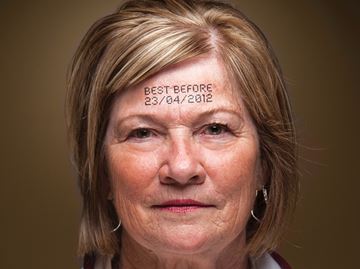
Ever notice how those who complain about being victims are themselves at least as likely to be perpetrators of the same offense? Examples that come to mind for me include the United States and Israel, two countries that portray themselves as targets of terrorism while carrying out wars of aggression whose death tolls far exceed their own losses. You’ll no doubt think of your own examples.
We’re seeing this projection at work with Millennial ageism. The Millennial generation is the most ageist in memory, yet the online media outlets they dominate discuss a problem that, if it really exists, pales in comparison: ageism against Millennials. But, like American presidents’ assertions that the United States has to protect itself against the world when, if anything, it’s really the world that needs to protect itself against the United States, it’s a joke.
Millennials’ status as members of the biggest generation in history – numbering more than 83 million, they have officially beaten the Baby Boomers – ensures that they will have a lot of power over American politics and the workplace, especially as they get older.
Which, if current experience serves to predict the future, they will abuse.
As I have written, ageism – the old-fashioned kind, by the young against the old – is endemic to Silicon Valley, the highest profile business sector controlled by people in their 20s and low 30s. Moreover, it’s normative: everyone thinks it’s OK. So OK do they think it is that national business magazines even publish articles saying it’s “smart” not to hire older Americans because they’re “dumber.”
I call it the old-fashioned kind of ageism because young-picking-on-old discrimination hasn’t been a thing since the “youth culture” of the 1960s and 1970s. Back in their hippie days, Baby Boomers in their 20s were so mean to their elders that they even made a movie whose plot involved putting people over 30 into concentration camps. As they got older, Baby Boomers flipped the switch, deploying their power as employers to discriminate against Generation Xers. Now that the Boomers are finally fading into the demographic mists, their Millennial children are beginning to repeat that half-century-old pattern, marginalizing and refusing to hire Gen Xers.
Ah, the great psycho of life.
While thinking about and researching this essay, I turned my critical eye to myself and my Gen X contemporaries. When we were in our 20s, didn’t we look down on older people? When we got a chance to hire and fire, didn’t we discriminate against those we viewed as boring and out of touch?
Not really.
Sure, we had more in common with members of our own age cohort than those older than us. But we didn’t look down on older folks…though many of them made fun of us (if they noticed us at all) and would rather let a job go unfilled than hire us.
I remember, for example, working as a staff writer for P.O.V. magazine. Almost all of us were in our 20s and 30s — not because management rejected older writers, but because older writers already had jobs elsewhere. But when editor Randall Lane brought on legendary sportwriter-barfly Bert Sugar as a columnist, not only did no one hold his age against him – he was pushing 60 and looked closer to 80 – everyone thought it was cool to add him to the team. Not just because he was “old school,” which we all admired, or despite his age, but because we appreciated the value that comes with experience. He had stuff to teach us; we wanted to learn, and hoped that some of that glory might rub off on us.
Compare that to the unceremonious departure of Mark “Copyranter” Duffy, 53, from BuzzFeed. Dude was the smartest man in the office; they fired him for being old.
I’ve never been into her music, but the cruel reception of Millennial-dominated media outlets to Madonna’s insistence on continuing to use sex to market herself at age 56 has me admiring her spunk (and, actually, finding her physically hotter than she was back in the 1980s). Also, I have to contrast the viciousness to the way that we Gen Xers treated older pop and musical figures at the same age.
As a record reviewer in my late 20s and early 30s, I can’t recall a single instance of an older rock or pop musician or group being dissed simply because he or she was old. If you sucked, you sucked. If you were good, you were good. If anything, our default mode was to tend to respect anyone who had stuck around for a while. We didn’t exactly respect our elders — as Gen Xers, we didn’t respect anyone, not even ourselves – but we didn’t disrespect them either. For us, it made perfect sense that punk rockers like The Clash admired old glam guys like Ian Hunter of Mott the Hoople.
That “rather die before I get old” crap was from the 1960s, not us.
The tendency of Millennials to denigrate their Gen X and Boomer elders is probably hardwired into the demographic reality of belonging to a big, dominant generation. One of the ways you feel good about yourselves is by picking on smaller, weaker groups. No matter what I or anyone else writes, even if every Millennial in the world reads it, there’s virtually no chance it will reduce their ageist tendencies.
Still, it’s sad. I think about my former literary agent and friend Toni Mendez, who died 12 years ago —at work — at the age of 95. She was more vibrant and interesting and outrageous and intelligent than a thousand typical 25-year-olds combined, and I still miss her terribly. Those 30-year-old gatekeepers in Silicon Valley and elsewhere who think that everyone over 35 has nothing to contribute are screwing themselves too, and leaving money on the table.
(Ted Rall, syndicated writer and the cartoonist for The Los Angeles Times, is the author of the upcoming book “Snowden,” the first biography of NSA whistleblower Edward J. Snowden. It is in graphic novel form. You can subscribe to Ted Rall at Beacon.)
COPYRIGHT 2015 TED RALL, DISTRIBUTED BY CREATORS.COM
United Rhapsody: Gag Me with A Pop Culture One Percenter
Culture has always been class-based. Rich people went to the opera; the poor listened to heavy metal. But what we read and watch and listen to is becoming segmented into more striations with wider gaps between them, reflecting income distribution.
I was thinking about this while reading that ultimate periodical for, by and about the richest one percent: The Sunday New York Times.
The Times is historically elitist: You get lots of reviews of classical music and fine arts, hardly anything about rock, hip-hop or comics. In Timesworld, a $150 dinner qualifies as a moderately expensive meal. A $650 hotel room is something you might actually consider.
But recently I’ve noticed that the gaps between what the Times prints to try to attract the audience targeted by its advertisers and the interests and tastes of most of its upper-middle-class striver readers are getting more pronounced. Just this weekend, I was tearing through the Sunday edition. (Despite lower page counts, it is still a whale of a paper.) I did it in under an hour.
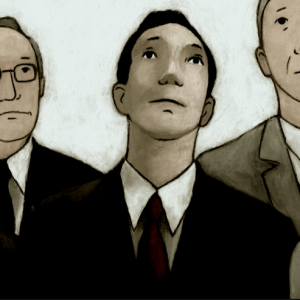 The Times doesn’t have many pieces I want to read anymore.
The Times doesn’t have many pieces I want to read anymore.
The paper was always a pretentious publication. Now it’s pretentious and blah. The Times delivers too many puff pieces on corporate executives, too many political horserace articles minus actual politics and way too many dreary profiles of boring authors, musicians, etc.
But the really big change in The Times? It’s the tone of the stuff they print.
Good writing draws you in no matter what the topic. A decade or two ago, you could count on The Times, more so than The New Yorker and The Wall Street Journal, to print words strung together in a way that would make you care about anything from asparagus cultivation to arbitrage. Now, not so much. Everything in there reads like it was written by a pod person on a triple dose of Prozac.
The Times is all flat-line affect.
Which, in a way, is interesting — interesting in a dull way but still interesting: You see, to make it as a successful journalist in 2015, you have to be able to make videotaped mass beheadings dull.
This is, in a way, a skill. But who has time to read it?
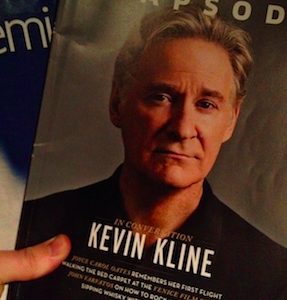 So, today I read The Times in a slow-down-to-check-out-the-car-wreck way. And I came across an item that brought home the widening cultural class divide. Here it is:
So, today I read The Times in a slow-down-to-check-out-the-car-wreck way. And I came across an item that brought home the widening cultural class divide. Here it is:
Breaking News! United Airlines has a new in-flight magazine, but it’s only for those who pay top dollar for flights. And it only features the type of literary fiction Timesians like long-time book critic Michiko Kakutani classify as “high-end.”
Good God.
Reports Alexandra Alter:
“As airlines try to distinguish their high-end service with luxuries like private sleeping chambers, showers, butler service and meals from five-star chefs, United Airlines is offering a loftier , more cerebral amenity to its first-class and business-class passengers: elegant prose “
 Alter continues, “There are no airport maps or disheartening lists of in-flight meals and entertainment options in Rhapsody.”
Alter continues, “There are no airport maps or disheartening lists of in-flight meals and entertainment options in Rhapsody.”
But wait. Rich people don’t need airport maps? How do they navigate airports — teleportation?
“Instead,” she writes, “the magazine has published ruminative first-person travel accounts, cultural dispatches and probing essays about flight by more than 30 literary fiction writers.”
She reports a list of authors that includes “literary stars like Joyce Carol Oates, Rick Moody, Amy Bloom, Emma Straub and Doerr, who won the Pulitzer Prize for fiction two years ago.”
I’m glad I’m in Coach. Every one of those writers bores the shit out of me.
To paraphrase the fictional Nazi in Hanns Johst’s play via Mission of Burma, whenever I hear the phrase “literary fiction” I reach for my revolver. Then I run away screaming.
Fiction is good or bad. There is no such thing as non-literary fiction.
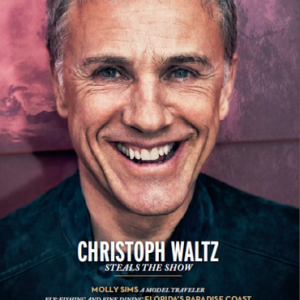 Purveyors of literary fiction sometimes wonder aloud why their non-genre genre doesn’t get more attention (from the marketplace). Though I infrequently observe a relationship between quality and sales, I can answer this question: literary fiction is written for an upper crust, very white, well-educated but not-as-smart-as-they-think sliver of the word-consuming public — whose number is too small to create a Stephanie Meyer-scale bestseller.
Purveyors of literary fiction sometimes wonder aloud why their non-genre genre doesn’t get more attention (from the marketplace). Though I infrequently observe a relationship between quality and sales, I can answer this question: literary fiction is written for an upper crust, very white, well-educated but not-as-smart-as-they-think sliver of the word-consuming public — whose number is too small to create a Stephanie Meyer-scale bestseller.
Ninety years ago, these would be the same people who hate Hemingway.
They hate anyone just for writing non-MFA approved sentences that anyone could read, understand, enjoy — and not notice.
To paraphrase Mark Twain, who argued that any library would be improved simply by the absence of any books by Jane Austen, I will endure United’s cramped coach class more stoically thanks to my awareness that there isn’t a copy of Rhapsody in the seat pocket in front of me.
The Times, again:
A United marketing flack ‘said the quality of the writing in Rhapsody brings a patina of sophistication to its first-class service, along with other opulent touches like mood lighting, soft music and a branded scent.’ “
Gag me with a plastic TSA-approved spoon.
But wait, there’s more …
‘We’re not going to have someone write about joining the mile-high club,’ said Jordan Heller, the editor in chief of Rhapsody. ‘Despite those restrictions, we’ve managed to come up with a lot of high-minded literary content.’”
Listen. There was a time, not long ago, during my own young adulthood, back when upper middle class and upper class people read the same books and magazines. The former aspired to the latter; the latter imagined themselves in touch with the former.
Now there’s literary fiction, a category designed as an exclusion.
In music, this is jazz. In movies, it’s documentaries and art films. It’s NPR and The Times and the Democratic Party.
Today, the rich live in gated communities of the mind. Every house and every person inside them look and talk exactly the same. No weeds on the perfectly manicured lawns.
Just boring, bland, flat bullshit.
As much as they work to keep us out, I know what keeps the cultural one percenters awake at night: Their very real fear that we don’t want to get it.
CDs are Dead. Long Live the CD!
Originally published by Breaking Modern:
Compact discs are dead. I realized this recently while shopping for a replacement for my dead 25-year-old Sony CD player; where there used to be lots of brands, now there are only a few and where there were many models, fewer still. Of course, this follows years of watching brick-and-mortar music stores — HMV, Tower, Virgin Megastore et al. — close their doors.
Perhaps it would be more precise to say that CDs were murdered. But was that just? Was that right?
Apple, which both predicts and creates the future, thinks streaming is the future — so they’re driving a stake through the heart of those shiny 5-inch discs whose design was supposedly inspired by an episode of Star Trek.
The computer giant recently ceased production of the signature device it introduced in 2001, the 160GB version of the iPod Classic. Says Will Dunn, editor of Stuff:
The iPod’s days have been numbered since the first iPhone, and the subscription model shows no signs of slowing down. Apple itself is transitioning into music subscriptions with iTunes Radio, and Google has just started trialling YouTube Music Key.”
Still, despite the pressure, many consumers prefer to own rather than rent their music.
Here’s Dunn again: “There’s still a huge affection for the iPod Classic and it’s not hard to see why – Spotify might offer 20 million songs, but 120GB of music is more than most people need, and your iTunes library doesn’t carry data charges or a subscription fee. Also, I think the Classic is a more distraction-free listening experience – I’m more likely to get through a full album on one.”
Music geeks have driven up the price of used iPod Classics on eBay and Amazon by hundreds of dollars more than their original cost.
Apple isn’t alone. Auto manufacturers have signaled that new cars will soon come with MP3 players, not CD players, standard.
2014 was a disastrous year for the music industry, with sales of both compact discs and MP3 downloads way down — to historical lows — as streaming gained steam. “Digital track sales are falling at nearly the same rate as CD sales, as music fans are turning to streaming—on iTunes, SoundCloud, Spotify, Pandora, iHeartRadio, and music blogs,” reports Derek Thompson of The Atlantic.
Before you sell all your CDs on eBay, however, you might want to think twice. Compact discs have a number of distinctive advantages over streaming and digital downloads.
CDs Win on Quality
“Steve Jobs was a digital pioneer, but when he went home, he listened to vinyl,” Neil Young noted in 2012. Audiophiles who know the difference say vinyl offers the richest, most textured listening experience. Though vinyl is decidedly superior to compact disc, the CD is better than MP3 as we know it.
Downloads and streams music is highly compressed in order to keep the data flowing and maximum storage space, but that efficiency comes at a cost. “True CD-quality files take up anywhere from three to 10 times as much as space as an MP3 or AAC file, depending on the latter’s bit rate; 24-bit files take up even more space,” according to PC Magazine.
Owning Beats Renting
Digital data is easy to lose. If you don’t believe me, Google “lost my iTunes music library.” Yes, sometimes it’s possible for the poor souls who somehow managed to erase thousands of dollars of music from their devices to restore them. Other times, not so much. Either way, the one thing you can be sure of is that it won’t be painless.
A friend – she was the first person to show me how cool the iPod was – got rid of all of her CDs after ripping them. Then some jerk broke into her apartment and stole both the player and the laptop to which she synced it. Just like that, she became a music pauper.
True, if she had downloaded all her songs from iTunes she could have gotten them back. To me, however, the bigger lesson is, I trust myself more than I trust some company. She should’ve held on to the CDs.
The Physicality of Music Is Rewarding
A woman from England wrote to NPR’s music blog: “When I was a teenager, I saved up to buy music, bought one CD or record at a time, and listened to the crap out of it. I knew all the lyrics, I knew melodies and bass parts, I had different recordings of the same track — all that. Now, I download a heap of music: some albums, some singles, some random tracks that catch my fancy. I listen to them a few times, and then they get lost in the iTunes pit of despair.”
Downloaded MP3s aren’t songs as much as they are items on a list. Stuff you stream on Spotify or Pandora doesn’t even rise to that level; it’s just something that you hear in passing the middle of a bunch of other stuff. Unless a song really stands out, you’re not going to pay close attention. The odds that a tune will grab you enough to learn the lyrics, much less change your life, are radically diminished by the combination of abundance and randomness inherent to post-compact disc formats.
I recently reorganized my extensive CD collection – aside from being a bit of a music addict, I reviewed records for many years and so have thousands of them – and found myself falling back in love with the physical form of the CD. While the artwork and liner notes in 5-inch booklets pale in comparison with their 12-inch vinyl predecessors, they’re better than nothing – and nothing is what we get when we stream or download. Like it or not, visuals matter.
Albums Force Serendipity
Remember the joy of discovery? On a vinyl album or a compact disc, the listener is “forced” to sit through “lesser” songs that, when they don’t work out so well, are viewed by fans and critics as contract-fulfilling filler. But that’s hardly the case for every band. In the digital age you can always download a single for 99 cents and avoid the dross — but what if the songs that never made it as hit singles for whatever reason turn out to be great? Odds are, you’ll never know. With a CD, you get to experience the full creativity of your favorite musicians as they experiment and stretch free of the constraints that come with trying to score that big hit.
Support Musicians, Not Streamers
Obviously you want the bands and musicians whose work you enjoy to make as much money as possible so that they’ll be motivated to soldier on. Unfortunately, digitalization has hit creative people hard, and musicians are no exception.
It’s pretty clear that, for the average band with a decent sized but not crazy fan base, compact discs are far more lucrative than digital radio and other contemporary formats.
Streaming services like Pandora and Spotify are notoriously parsimonious with artists, and at this point anyone with a conscience really shouldn’t be supporting them.
You Can Sell CDs …
Although the price per song is roughly the same when you compare a 99-cent download to a $14 CD with 13 songs on it, the price differential changes radically when you consider the fact that you can easily sell a used CD. If you have good taste, in fact, you could probably make a pretty good living investing in CDs – I’ve noticed that many of the CDs I bought for $12 way back when are worth $50 or more to collectors.
That’s a better rate than I got on my 401(k).
You could even make a habit of purchasing physical compact discs, ripping them at the highest possible quality to save and sell them. In many cases, you would probably be getting a dozen songs for just a couple of dollars. And then you wouldn’t be stuck with all those discs to store.
Just make sure to keep a backup hidden away in case my friend’s burglar drops by.
One Hour a Day Earbud Limit? WHAT?
Originally published by Breaking Modern:
The World Health Organization (WHO) now warns teens and young adults that they are at high risk of hearing loss if they listen to music on headphones more than an hour a day. Buy in open office spaces, headphones are required to keep out distracting noises … including co-workers’ music.

New Music, Old Rockers and Young Punks Forever
Originally Published by Breaking Modern:
Used to be, bands peaked out early.
The good ones cranked out three or four great albums before drugs, complacency, exhaustion, fights over girlfriends or money began to take their toll. Then they’d either break up or, not being suitable for gainful employment or lacking the imagination to try something new, soldier on.
It’s a sad old story for generations of oldsters before you. As time passed and many of the fans moved on, diehard loyalists made do with new albums and then CDs that sounded enough like the glory days to keep them satisfied and turning up at concert halls. This kept grizzled old rockers on time with the rent — but rarely if ever achieving the magic spark of the early years.

This happened even to the most brilliant rock and rollers any music freak alive today has heard about and even listened to.
Take David Bowie. He was good for seven or eight iconic albums, but since the early 1980s we lost all hope of another soaring achievement at the level of, say, Aladdin Sane.
And the once great Elvis Costello turned out one amazing disc after another between 1977 and 1988, but by the mid-1990s it had become clear that, despite his admirable willingness to stretch outside of his comfort zone with collaborations with artists working in other genres, the new stuff was pretty much only going to appeal to Declan’s hard-core fans.
Look, you spend the first 20 or 30 years of your life accruing experiences for songs that go into your first few records. Then you become a professional musician, and pretty much the only thing that can go into your new stuff is what you did last year, while you were touring and negotiating with your surly record company.
And unless your wife or mistress (or both) dumps you, your muse just doesn’t have that much to work with.
But the old slow-fade dynamic appears to be a thing of the past.
I don’t know if musicians are responding to the fiscal pressures of digitalization, which has made it more difficult for creative types to monetize their work, or maybe it’s just a 2015 thing. I’ve been amazed, lately, at some of the great new music old bands now are releasing.
Now, this isn’t like Bob Dylan, whose every musical fart is always greeted by corporate music media as though, well, it didn’t really suck. That guy was old when I was a kid and he’s been boring for years. We’re talking about bands who have been around a long and actually really keep getting better. Like they practice. Or something.
Bear in mind, many of these reboots result from the kind of personnel changes that typically destroy bands. I mean, imagine if the post-Jim Morrison Doors LPs were as good or better than even the original Doors, as opposed to the notorious disasters they actually were. Imagine if it not only didn’t matter that guitarist Mick Jones of the Clash – who wrote most of the songs – was missing from “Cut the Crap.”
Is such a thing even possible?
Well, maybe so. Or maybe the veteran performers whose new stuff is so good benefited from never playing huge arenas or being able to afford distractingly large mounds of cocaine. Clean living and poverty have some real awards to artists.
The Buzzcocks: Brit Punk Gone Wild
Consider legendary British punk rockers, The Buzzcocks, and its most recent album. Not so excitingly named “The Way,” it continues a remarkable forward movement for a group that burst on the scene with androgynous lyrics about the politics of romance and relationships going back 40 years ago.
Like many bands from this punk generation, The Buzzcocks broke up in the 1980s and reformed in the 1990s. And this band returned full force. It kept its signature buzzsaw guitars and still maintains its core concerns, all while evolving its signature sound and songwriting chops.
Highlights of the reunion period include “Modern” (1999), the self-titled non-debut “Buzzcocks” (2003) and 2014′s “The Way,” which switches back and forth between songs written and sung by Pete Shelley and Steve Diggle. “Virtually Real,” about social media, would come off as contrived and insipid in the hands of lesser social satirists. In the hands of Buzzcocks, it’s a gem.
Client: Frosty English Electronica

Hard-hitting English electronica band Client has reveled in mystery since its founding in 2002. The group’s two original members were identified only as Client A and Client B, and their images never appeared on their CD artwork. Blending retro 1980s synthesizers and frosty lyrics influenced by the late singer Nico and the early 1980s French Cold Wave movement led by KaS Product, Client was a reliable favorite – until Sarah Blackwood, the lead singer of Dubstar formerly known as Client B, left the band.
This is one of those situations that usually spells music death. Yet the 2014 CD “Authority” not only maintained enough of the original musical and conceptual aesthetic to satisfy existing fans but moves things forward with more forthright political commentary on the nature of oppression in the 21st century, all to an inevitable dance beat set behind a new singer whose voice is different enough from Blackwood’s to carve out her own territory while moving the band forward.
Don’t get me wrong: I still love the old albums. But the new one is just as good, if maybe a bit more contemporary.
the dB’s: a Return to ’80s American Pop Power Form
For my money the seminal American power pop band the dB’s never recaptured the highs of their somewhat neglected 1984 masterpiece “Like This.” Yet here we are, three decades later, after a series of on-again off-again albums, including the insanely flat 1994 “Paris Avenue,” with “Falling Off the Sky.”
Okay, so this one came out in 2012, but I didn’t notice and neither did many other people so I’m talking about it now.
Critics like to say this a lot, but this really is a true return to form, plus it moves the band forward in a way that doesn’t spell “old.”
The Adverts: TV Smith and Melodic Post Punk

Of the many unjustly overlooked musical artists out there, there has never been a bigger gap between soaring talent and popular obscurity than that of singer-songwriter TV Smith, formerly the lead singer of the Adverts, who were contemporaries of the Buzzcocks in the late 1970s in the UK. Smith writes heart-wrenching, droll elegies to those crushed by the steamroller of heartless capitalism (e.g., “It’s Expensive Being Poor“) to delightfully melodic postpunk.
Year after year, he puts out one CD after another, each better than the one before, which was itself amazing. Most recent was last year’s “I Delete,” which blends elements of classic late 1970s British punk, 1980s hair metal, 1990s grunge, early 21st century postproduction gimmickry and pretty much everything else that has ever mattered to me. Lots of amazing songs here, but “It Don’t Work,” about the feelings and failings of technology on both a personal and political level stands out. It’s unbelievable to me that this is a guy who made it big with a 1970s novelty song, “Gary Gilmore’s Eyes.”
Frank and Walters: Irish Alternative Bond

Finally, another revelation, which thanks to the Internet I just found out about even though the thing came out in 2012, is that the Frank and Walters, an alternative rock band from Ireland famous for their jangly guitars and beautiful, winsome lyrics about the nature of desire who formed in 1990, got back together and issued a new CD, “Greenwich Mean Time.” Here the triumph isn’t so much that they moved forward. They didn’t.
“Mean Time” sounds like they never went away. It’s a seamless transition from 2006 to 2012, which is kind of amazing when you think about it.
Sometimes, when you love a band, more of the same is good enough. And sometimes, rarely, it might even be better.
SYNDICATED COLUMN: Schools Should Teach Nowology

Everyone has a strong opinion about education. But the controversies are always about the same topic: testing, teachers unions, funding, merit pay, vouchers/school choice, charter schools. Is college a smart investment? Is affirmative action fair? Has political correctness supplanted the basics?
I keep waiting for someone to bring up Now. As in the study of now — what’s currently going on in the fields of politics, history, literature, mathematics, science — everything.
Can we call it Nowology?
From K through 12 through senior year of college, American education focuses obsessively on the past. No matter what you study, the topics either relate to the past or the knowledge is dated.
Since I was a history major in college, I’ll focus on that.
I’ve never understood why history is taught chronologically. A book’s opening is crucial; either you get hooked straight away, or you get bored and turn blasé. So how is it that textbook publishers think it makes sense to start a fourth-grade history textbook with prehistoric humans who lived 10,000 years ago? It’s tough enough for me, at age 50, to relate to our hunter-gatherer ancestors. How can a typical American 9-year-old, who lives in the suburbs, connect intellectually to people who foraged for food (not in the fridge)?
Another problem with teaching history chronologically is that teachers rarely make it to the relevant, interesting history students might actually care about — what’s going on now. From junior through senior high, my high school teachers got bogged down in the battlefields of the Civil War. We never once made it as far as Reconstruction (which is actually fascinating), much less to the controversies of my childhood (Vietnam, Watergate, the Iran hostage crisis).
TV, radio and newspapers — that’s where what mattered was discussed. My classmates and I had fathers who served in Vietnam. We had neighbors who’d dodged the draft, whose faces stared at us from wanted posters at the post office. We argued over Nixon and Ford and Carter, but all that stuff — the controversy, the drama, the Now — took place outside school.
The not-so-subliminal message soon sunk in: school is where you learn about old stuff. Now stuff is everywhere else.
This is, of course, exactly the opposite of how we choose to teach ourselves.
Example: pop culture, like movies and music. No one’s musical education begins with recordings of recreations of primitive music, simple claps or banging objects together. Most children start out listening to contemporary music — whatever they hear on Pandora, Spotify, the radio, TV, etc. Those who decide to dig further usually work backward. They listen to older works by their favorite artists. They hear a musician talk about the bands that influenced them, and they check them out.
(When I was a kid, friends were surprised that Paul McCartney had been in some other band before Wings.) They might wind up getting into ragtime or Bach. Last. Not first.
Ditto for movies. No one starts out watching silent films.
There is some discussion of teaching history in reverse chronological order in other countries. Writing in the UK Prospect last year, Christopher Fear of the University of Exeter argues: “We should begin by showing children how to scratch the surface to find the recent pasts of their parents’ and grandparents’ generations — pasts which they can talk about together.” But the British too continue to teach history the boring/chronological way.
We’re constantly worrying about whether our schools are preparing children to compete in the global marketplace. To support their calls for reform, activists (mostly, but not exclusively, on the political right) point to surveys that show that Americans are woefully ignorant about basic facts such as evolution, essential geographic knowledge as the location of the country where U.S. troops have been fighting, killing and dying for a decade and a half, and even heliocentricity.
Sure, it would be nice if more Americans cracked open a newspaper (or its online edition) now and then. On the other hand, a lot of this material ought to be taught in schools — and it isn’t. Day one of American history class should begin with Obama, Congressional paralysis, the early jockeying for the 2016 presidential campaign, America’s clash with Russia over Ukraine, and the wars against Afghanistan and Iraq. All of these subjects naturally require digging deeper, back in time, to explain why and how what’s going on now is happening.
And it’s not just history. Studying physics at Columbia in the 1980s, no one taught us about the latest advances in cosmology and quantum mechanics — some of which, ironically, were being discovered in labs in the same buildings by the same professors who were filling our heads with obsolete material.
Nowology: better late than never.
(Support independent journalism and political commentary. Subscribe to Ted Rall at Beacon.)
COPYRIGHT 2014 TED RALL, DISTRIBUTED BY CREATORS.COM

